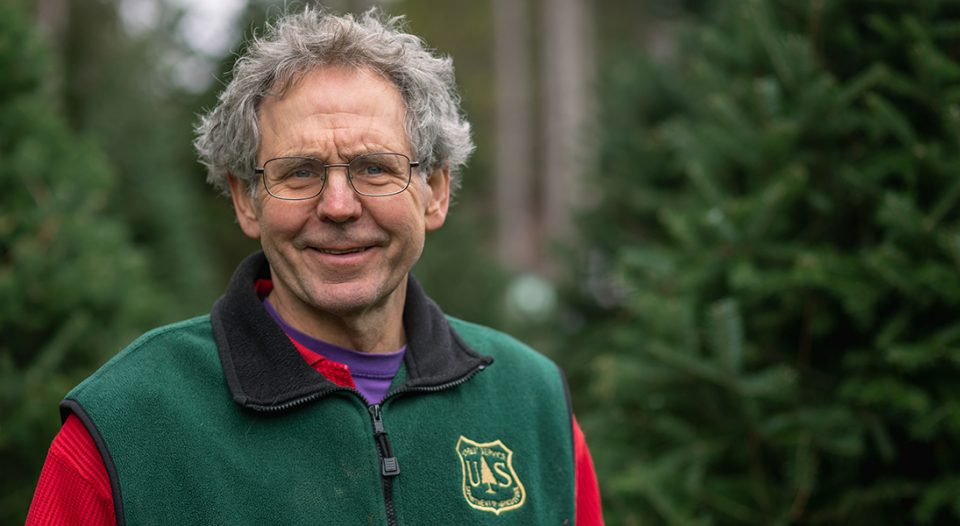St. Anthony Park Lutheran Church, St. Paul, Minn.
Partner, co-owner of Hansen Tree Farm; member, Minnesota Christmas Tree Association; retired research forester, U.S. Forest Service; volunteer, University of Minnesota forestry research; volunteer, Boy Scouts
My most favorite memories of church are from high school youth group wilderness trips. I still remember every detail of a canoe trip I went on in 1968. Our leader shared about being closer to God and about spirituality in nature. As an adult, I’ve been a trip leader with a youth minister or associate pastor from my church. We went to a camp called Christikon in Montana, hiking and backpacking there. We have also done canoe trips to the Boundary Waters and Lake Superior.
One thing I’ve tried to emphasize when we’re on a backpacking or canoe trip: the wilderness is not just something to conquer. It’s a place of meditation or being alone and bringing yourself closer to those you’re there with, because you’re in a more primitive situation and you need to rely on each other. The whole concept of being at one with yourself and others and nature and God is important to me.
I wanted a career that got me outdoors. I was also very good at math and computers and statistics and was very much into that end of forestry. It was a career path that allowed me to use my talents tied to the outdoors.
A lesson from forestry is that change is not instant. In forestry, you measure small changes. You’re looking at and seeing trees that change very slowly, but inevitably, they change. Now I see trees that I helped plant years ago that are huge. The same is true in life: The things we do now, we may not see the changes for a long time or the impact we want. Change will come.
My father started planting Christmas trees when they were becoming sort of an industry in Minnesota. He bought our property in 1950—bare farmland on the outskirts of the Twin Cities metropolitan area. It was a hobby and part-time endeavor. He was a forestry professor at the University of Minnesota and involved in Christmas tree planting and research, too, but it wasn’t a major part of his work. By the time I was in high school, all the trees we’d planted were either old or overgrown.
“I see trees that I helped plant years ago that are huge. The same is true in life: The things we do now, we may not see the changes for a long time.”
In the mid-’80s, after both my brother and I were established in our homes and families, we decided to reactivate our property as a Christmas tree farm. We decided to leave some areas to grow back to forest. Of the 40 acres of land we now have, about half is Christmas trees and the other half is old Christmas trees from the ’50s and forestland. We’ve been doing this work on a part-time basis—weekends and holidays—year-round, with 90% of the business coming Thanksgiving weekend and the weekend after.
A lot of people are shocked by how much work there is to grow trees—the unpredictability of it, that you can’t be guaranteed anything. It’s very dependent on the weather.
I’m a firm believer that we need to move to carbon neutral and do something about global warming. I’m not out there protesting—that’s not my biggest concern—I try to conserve gas and do this and that to effect change.
I’m a Lutheran because it was the way I was born and raised. I find Lutherans to be open and caring, loving and concerned but not overbearing or pushy about it. I’ve been a member of St. Anthony Park my whole life, except for a year when I worked in Louisiana. The church has been very important to me.
I do a lot of bike riding and touring. I spend a day riding 50 to 70 miles and then touring that way. When I’m alone on a bike—especially a road I’ve never been on—I feel God’s presence.
“A lot of people are shocked by how much work there is to grow trees—the unpredictability of it, that you can’t be guaranteed anything.”
My doctorate research was incorporating a computer model into how the U.S. Forest Service did our tree inventory. We have inventory plots that we measure periodically. Our whole system measured a plot. They are randomly laid out over the course of the country. They get measured every so often dependent on funding. Then we go back and see how the trees have changed. We used computer growth modeling to optimize how often to measure the plot and get more information out of them.
I’m very active with the neighborhood scout troop. Some of the kids in the church youth group are members. We go on campouts and wilderness trips. Before Christmas, they sell wreaths from our tree farm as a fundraiser.
I pray that people understand each other. That we as people get over our petty differences and realize that we are all different, but we need to accept that.
Just this year I donated a kidney. It was something I thought about for a long time. What prompted me to do it at this time was learning that a friend was in need of one. There’s a need out there, and I felt that it was something I could do at my stage in life.
Many of our friends are part of the same congregation. I really appreciated their support following the deaths of my parents and my brother. We did both memorial services at St. Anthony.






